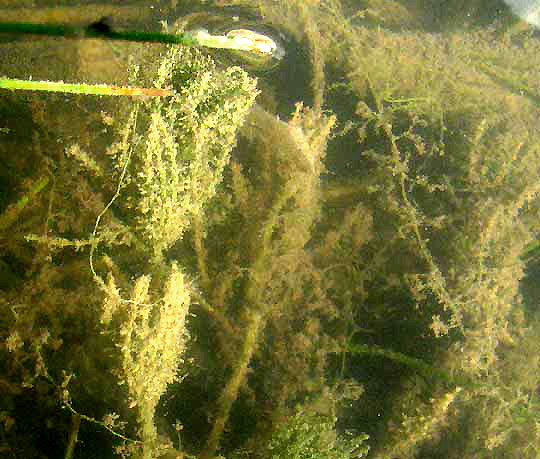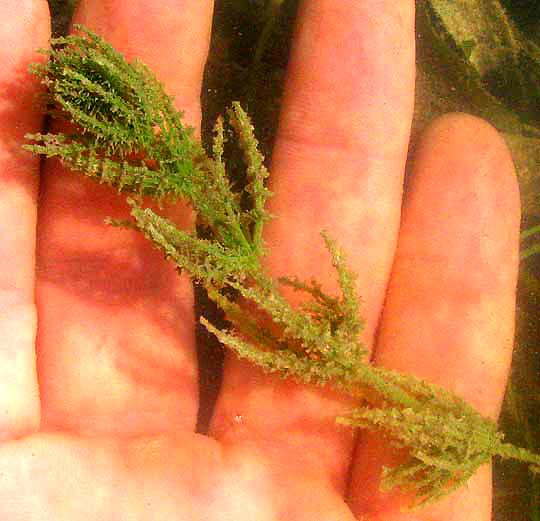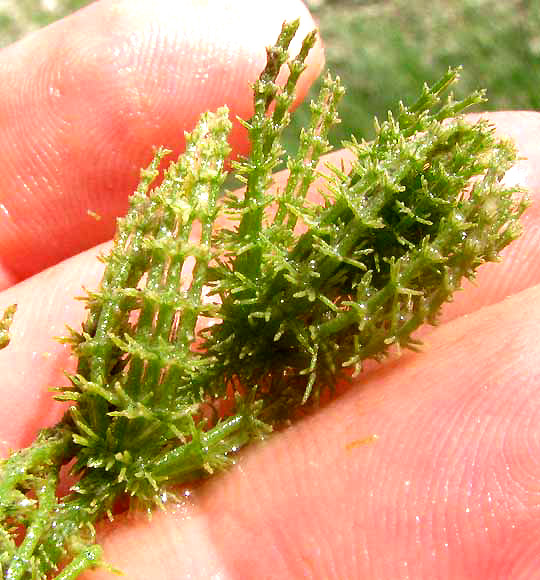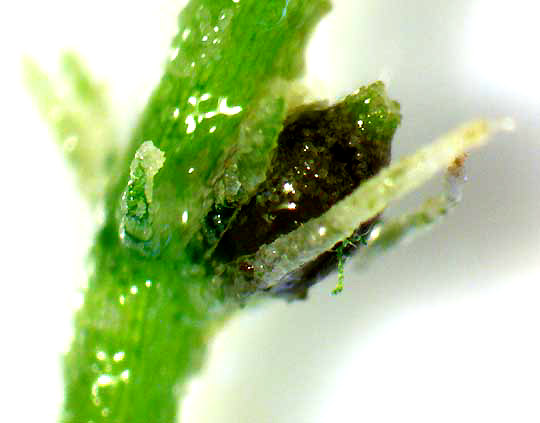Excerpts from Jim Conrad's
Naturalist Newsletter
from the August 18, 2013 Newsletter issued from the Frio Canyon Nature Education Center in the valley of the Dry Frio River in northern Uvalde County, southwestern Texas, on the southern border of the Edwards Plateau; elevation ~1750m (~5750 ft); N29.62°, W99.86°; USA
CHARA
Submerged aquatic vegetation in the Dry Frio River's drying-up pools is heavily coated with the gray-brown, muddy, calcium-carbonate-rich marl we looked at recently. In the same pool in which cricket frogs were so abundant among cow-trampled pondweeds, my attention was drawn to the marl-covered aquatic plants shown below:

At the right in that picture we see a submerged, marl-covered network of fine leaves and stems of the carnivorous Bladderwort we've met at https://www.backyardnature.net/n/h/utricula.htm.
At the picture's left, there's something else. Even so heavily laden with marl we can make out numerous leaves arising from a stem in a whorled pattern -- with many slender blades arising from each stem node. Elsewhere in pools of the Dry Frio we've seen watermillfoil with whorled leaves, as shown at https://www.backyardnature.net/n/h/watermil.htm.
However, the whorls on this aquatic plant are much farther apart than those of watermillfoil. Reaching beneath the water I shook off most of the sprig's marl and got a better view of the plant's form, shown below:

Clearly this isn't watermillfoil. I plucked off a stem tip, scraped off as much marl as possible, and now could see the the strange anatomy exhibited below:

The plant bore no flowers or fruits and I wouldn't have had the slightest idea what it was, except that on ocean beaches I've seen certain algae looking like this. Once I began thinking in terms of "large, freshwater algae" it didn't take long to figure out that this is a green alga member of the genus CHARA in the Stonewort Family, the Characeae. The name stonewort derives from the fact that typically plants in the family live in freshwater in limestone areas throughout the northern temperate zone, where they're often encrusted with calcium and magnesium carbonates. This mineral encrustation makes them feel brittle, gritty, or "stony" to the touch. Numerous Chara species are recognized but I can't distinguish them.
Since Chara species are algae, they bear no flowers or fruits. They reproduce both vegetatively and sexually. Vegetative reproduction takes place by tubers, and special alga structures known as "amylum stars" and "secondary protonema." The sexual organs consist of male "antheridia" and female "archegonia." On our sprig I couldn't find antheridia, but female archegonia were numerous, apparently the male parts having already issued their sperm and fallen from the plant. Below you can see an archegonium beneath the dissecting scope:

A new Chara plant can develop from the developing cells in the archegonium.
Ecologically, Chara alga stabilizes bottom sediments, provides food for waterfowl, and cover for fish. It creates habitat for many micro and macro invertebrates, which are important foods for fish, and the alga is consumed by many species of ducks. However, on the Internet more pages can be found selling chemicals to kill Chara than those extolling Chara's virtues. I read that Chara often is called muskgrass or skunkweed because of its foul, musty, almost garlic-like odor, though I smelled nothing, maybe because there was so little of it.
These are primitive plants. Because of their stony covering, throughout evolutionary history they've often preserved well in the fossil record. Paleontologists can recognize extinct relatives of Chara from strata deposited as early as the Devonian Period, over 300 million years ago.